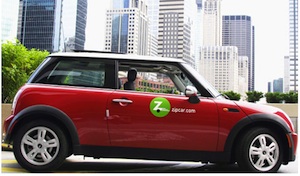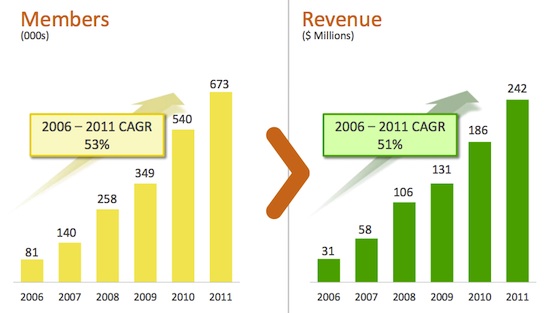Focus Article: Zipcar Inc. (ZIP)
Zipcar Inc. (ZIP) $7.90
The Company:
Founded in 2000, Zipcar is a car sharing company that allows customers to rent cars for as little as an hour primarily from densely populated urban areas and over 250 University campuses. The key mantras of the company appear to be fun, accessibility and sustainability. The company has over thirty models of cars and you get to pick cars like the Mini Cooper and a plug-in hybrid instead of the standard choices available at most regular car rental companies. Zipcar rental rates include gas, insurance and 180 free miles in stark contrast to the upsell on everything from GPS to insurance that traditional car rental companies put customers through. The company claims that every Zipcar removes 15 cars from the road as Zipcar users (Zipsters) tend to drive 40% fewer miles annually after becoming members.
For years I have been traveling to Oregon for business and my usual behavior is to rent a car at one of the car rental companies and check into a hotel close to where my client is located. During my last trip, I happened to stay closer to downtown and realized that I barely touched the rental car as it was easier to walk to most places. While working on this article, I looked up Zipcar locations in Oregon and found that they park four cars within walking distance of where I usually stay. It appears that if I were to take a cab to my hotel and used Zipcar a couple of times during my stay, I could save between 60 to 70% on my car rental costs.
The biggest challenge Zipcar faces is a change in consumer behavior and getting the word out more effectively to its potential customers. The company has a very strong brand that is widely recognized. However its recent experiment of using radio advertising to increase its membership yielded dismal results. I was actually surprised to see that the company’s customer acquisition costs were just $42/customer in 2011 and the average lifetime value of a member is $537. Based on that failed radio advertising experiment and other advertising channels the company might explore in 2012, I expect customer acquisition costs to go up. If the company can maintain churn at the current 2 to 3% range, it could have a decent business on its hands in a couple of years.
Everything is not bright and sunny in Zipcar land. There are hidden or at least not clearly explained costs related to renting from Zipcar. The company has been sued twice by customers for charging various fees such as a $50/hour late fee, a fee to talk to a “live” customer service representative and an “inactivity” fee. Most of these claims were thrown out except for the one related to the inactivity fee. Higher margin fee revenue as a percentage of overall revenue has been growing steadily and represented 14% of total revenue in 2011. While this helps the company’s bottom line, increasing fee revenue to the company’s long-term target of 17% of revenue might backfire and risks alienating customers. While traditional car rental companies are highly profitable and consolidation within that industry has pushed up rental rates, Zipcar has been struggling to post a profit. The company also has to pay for expensive parking spots to make its cars more accessible in densely populated urban areas. The number of car models offered could also add to operational complexity and higher maintenance cost per vehicle.
The company has been expanding both geographically as well as through unique product offerings. Zipcar is currently operating in the United States, Canada, Spain, United Kingdom and Austria. It has also introduced a van sharing program called Zipvan that allows members to rent Ford E-150 full size cargo vans at rates starting at $15.75/hour or $104/day which includes 180 miles, insurance and gas.
Business Statistics & Financials:
Zipcar has been a tremendous growth story as illustrated by the following chart. The company is profitable in its established markets of Boston, New York, Washington DC and San Francisco but is not consistently profitable on a GAAP basis. The second and third quarters appear to be the strongest for the company but the stock cratered following Q2 2012 earnings as the company posted a small net loss and revenue growth moderated to 15% growth Year-over-Year. The company went public last April at $18/share and closed its first day of trading at $28. The stock is down nearly 72% since then and dropped as low as $6.50 intraday on August 3rd after releasing Q2 2012 earnings.

While this growth in members and revenue is impressive, not all of it is organic. The company merged with Flexcar in 2007 and acquired UK based Streetcar in 2010. Zipcar also picked up a controlling stake in Barcelona based Avancar and acquired Vienna based Carsharing.at. In addition, Zipcar was also the lead investor in a $13.7 million Series A round for Wheelz, a peer-to-peer car sharing network that allows customers to rent cars from other people in the network.
The company trades for 9 times trailing 12 months operating cash flow and 1.2 times sales. I have summarized the key business metrics for Zipcar in the table below.
| Zipcar by the Numbers: (Q2 2012 unless specified otherwise) | |
| Number of Vehicles | > 11,000 |
| Number of Customers | 732,000 |
| Revenue per Vehicle per Day | $65 |
| Average Purchase Cost of Vehicle (2011) | $20,000 |
| Monthly Cost per Vehicle (2011) | $1,000 |
| Monthly Revenue per Vehicle (2011) | $2,000 |
| Quarterly Revenue | $70.81 million (up 14.52% YoY) |
| Fee Revenue (% of total revenue in 2011) | 14% (up from 12% in 2010) |
| Acquisition Costs per Customer(2011) | $42 |
| Average Lifetime Value per Customer (2011) | $537 |
| Monthly Customer Retention Rate | 97.7% (97.8% in Q2 2011) |
| Established Markets Revenue (Boston, NY, DC, SF) | $39.76 million (up 15.51% YoY) |
| Established Markets Income Before Tax | $8.68 million (up 16.35% YoY) |
| Adjusted EBITDA Margin | 4.8% (up from 3.73% in Q2 2011) |
Competitors:
Zipcar has a big competitor list which includes rental car companies of traditional and non-traditional origin. Some of the traditional rental companies include Avis, Enterprise, Hertz and U-Haul. Enterprise has a car sharing program called WeCar that operates in three countries and several university campuses. Hertz also has a car rental program called Hertz On Demand that has a sizable presence in certain markets like New York. The traditional car rental companies like Hertz and Enterprise are likely to move slowly into this segment as they could potentially risk cannibalizing their profitable car rental business.
The non-traditional competitors include several start-ups such as Relay Rides, Getaround, Go-op and Wheelz that provide cars on a peer-to-peer rental basis and do not have the same constraints as the traditional car rental companies. RelayRides looks like a really fun concept and I found dozens of cars in several cities that I checked out. I also noticed that most of the cars have never been rented out. So it looks like it may take time for this concept to catch on. Zipcar is hedging its bets through its large investment in Wheelz but in terms of pricing, safety and quality, the peer-to-peer companies don’t seem to have much of an edge on Zipcar.
| Stock | Symbol | Mkt Cap | EV/EBIDTA | P/B | Operating Margin |
| Zipcar, Inc. | ZIP | 316.1M | 0 | 1.42 | 0.77% |
| Hertz Global Holdings, Inc. | HTZ | 5.96B | 12.36 | 2.65 | 13.91% |
| Avis Budget Group, Inc. | CAR | 1.75B | 12.58 | 3.64 | 13.57% |
| Dollar Thrifty Automotive Group Inc. | DTG | 2.43B | 9.34 | 3.56 | 24.32% |
Insider Buying:
One insider purchased stock on the open market over the last six months as listed below. Mr. Case is the founder of AOL and his interest in Zipcar comes from his ownership of Flexcar through his investment firm Revolution LLC. As mentioned above, Flexcar merged with Zipcar in 2007. You can view a list of all insider transactions for Zipcar here.
| Owner | Relationship | Date | Cost | # Shares | Value($) | Total Shares |
| Stephen M Case | Director | 28-Aug | $7.75 | 255,311 | 1,978,660 | 1,000,000 |
| Stephen M Case | Director | 23-Aug | $7.91 | 160,500 | 1,269,555 | 744,689 |
| Stephen M Case | Director | 22-Aug | $7.98 | 134,900 | 1,076,502 | 584,189 |
| Stephen M Case | Director | 21-Aug | $7.99 | 66,589 | 532,046 | 449,289 |
| Stephen M Case | Director | 17-Aug | $7.99 | 13,300 | 106,267 | 341,376 |
| Stephen M Case | Director | 16-Aug | $7.99 | 400 | 3,196 | 328,076 |
| Stephen M Case | Director | 20-Aug | $7.99 | 41,324 | 330,179 | 382,700 |
| Stephen M Case | Director | 10-Aug | $7.94 | 61,700 | 489,898 | 327,676 |
| Stephen M Case | Director | 8-Aug | $7.83 | 89,600 | 701,568 | 202,500 |
| Stephen M Case | Director | 7-Aug | $7.55 | 112,900 | 852,395 | 112,900 |
| Stephen M Case | Director | 9-Aug | $7.74 | 63,476 | 491,304 | 265,976 |
| TOTAL | 1,000,000 | 7,831,570 |
Risk Factors:
The biggest risk with Zipcar is that there does not appear to be much of a moat to the business. Competition appears to be fierce both from traditional and non-traditional rental companies. If Zipcar manages to change consumer behavior in a meaningful way, there is very little to stop others from taking a piece of this new market pie.
As the company scales its fleet of vehicles, high capital expenses are eating into what little operating cash flow Zipcar is generating and there is a possibility the company may have to issue more debt or dilute shareholders through a secondary offering.
Conclusion:
Zipcar’s brand value (AdvertisingAge picked it as one of America’s Hottest Brands in 2009) and large network of 732,000 members gives it a solid head start in a new market segment but whether the company manages to scale to a level where it can be consistently profitable remains to be seen. The company continues to post double digit revenue growth (albeit at a slower pace) and also managed to post profits in two of the last four quarters. Customer retention rates remain high (it is a little odd to see the company report monthly customer retention rates rather than annual churn), average daily revenue per vehicle is growing and fee revenue is also growing. While I really like the Zipcar story, I think it is currently a risky investment that will bear fruit in 2013 or beyond provided competition does not heat up.
